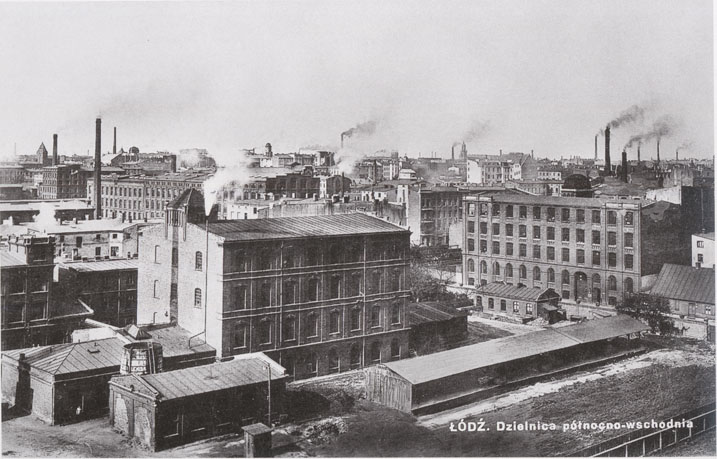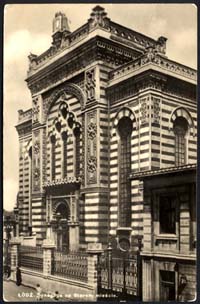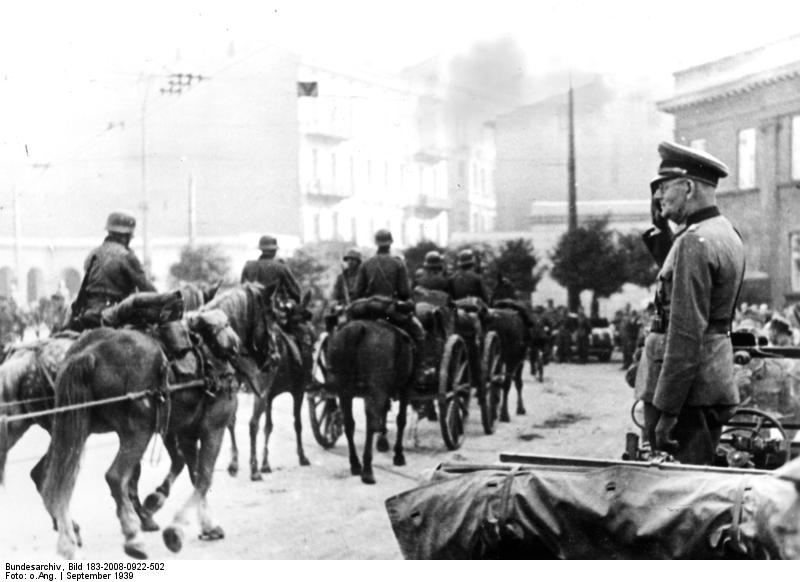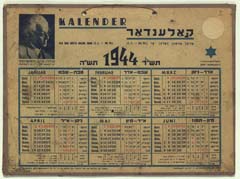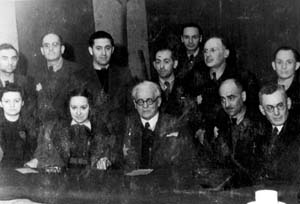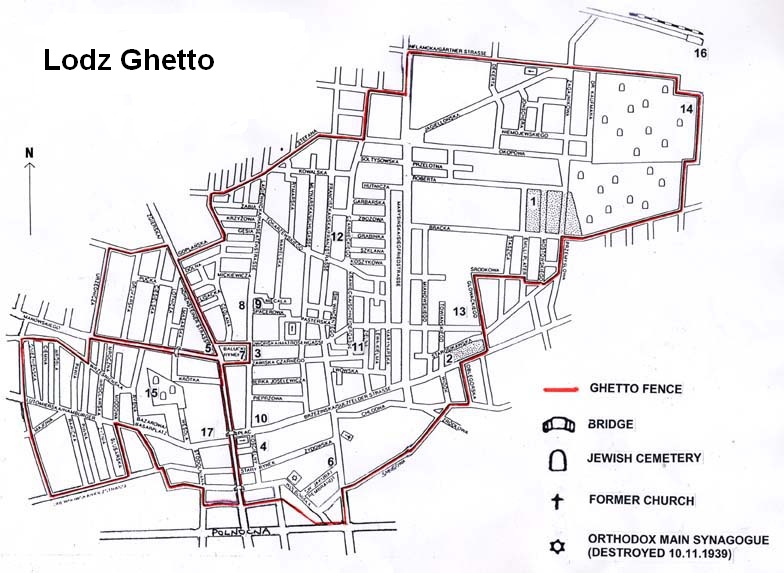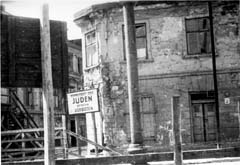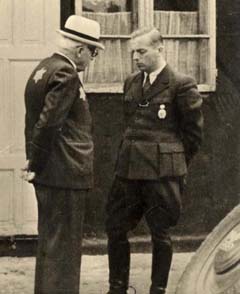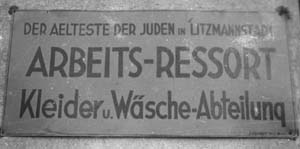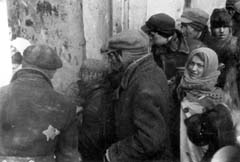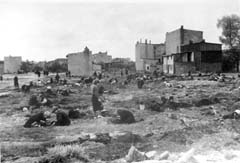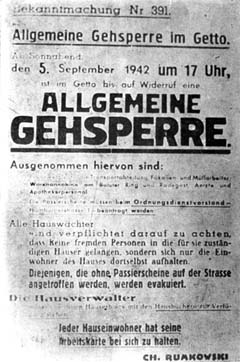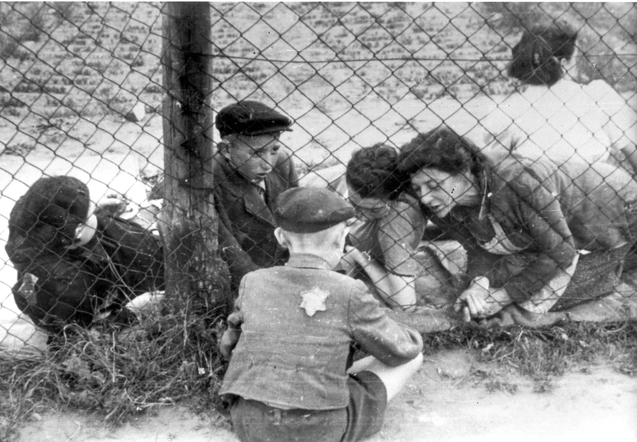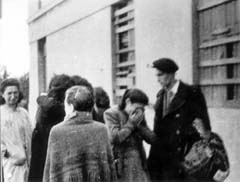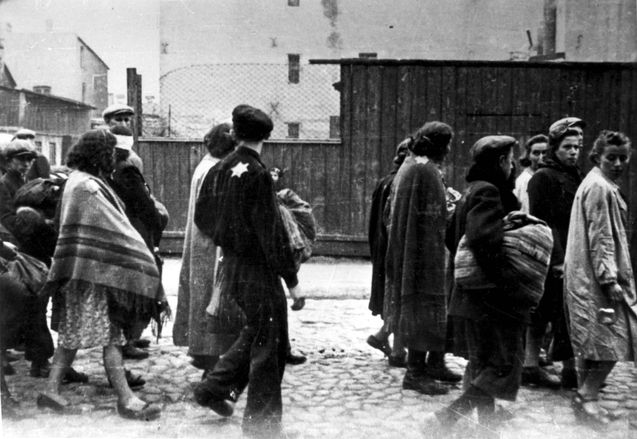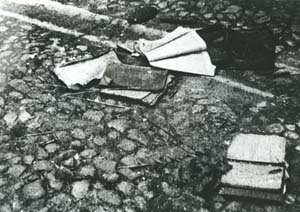Lodz and the Lodz ghetto
Rywka Lipszyc’s hometown of Lodz, Poland was the site of the most isolated and oppressed ghetto in all of Nazi-occupied Europe. Yet before World War II, and even more so during the half-century before World War I, the metropolis had a well-deserved reputation for cultural pluralism and economic dynamism. From 1865 to 1914, four ethnic groups coexisted side by side and the population grew an astounding 17-fold.
By 1900, Jews constituted nearly a third of the population and half of the businessmen in Lodz. They interacted with the Poles, of course, but also with the two other large minority groups: ethnic Germans, known as Volksdeutsche, and Russians. Inter-ethnic relations were relatively good for East Central Europe, for no single group had majority status. The Poles were the largest group, but the Jews, Germans, and Russians collectively outnumbered them. The communities usually did not mix socially, but tolerance generally prevailed and four languages—Polish, Yiddish, German, and Russian—were heard on the streets and in the stores.
After World War I, Lodz became part of the new Polish Republic. With the flight of the Russians and the emigration of many Volksdeutsche, the demographic balance shifted in favor of the Poles. After 1918, they were unquestionably the majority and—after more than a century of foreign rule—finally the masters in their own house. Still, Lodz’s diverse Jewish population of more than a quarter of a million souls continued to comprise almost a third of the city. With its Chasidim and Orthodox, Bundists and Folkists, every manner of Zionist, and assimilationists, Lodz was home to the second largest Jewish community in the new Poland and smaller in size only than Warsaw.
Especially after the death in 1935 of Poland’s chief of state, Josef Pilsudski, who during a nine-year rule had sought to protect the national minorities, antisemitism intensified in Lodz, as in the rest of Poland. It emanated from the government, the Church, and chauvinistic pressure groups. But Rywka Lipszyc, born in 1929, and enrolled in a traditional Jewish day school for girls, was no doubt buffered from most of the hatred and discrimination. Her childhood revolved around her respected rabbinic family, her friends, and her studies. She likely felt fairly secure.
Select one of the sections below to learn more.
Nazi Germany Invades Poland
Yet with Hitler’s invasion of Poland on September 1, 1939, the world as Rywka knew it came to an end. In the first week of World War II, the Wehrmacht overran Lodz, less than 100 miles from the German border. Poles and Volksdeutsche immediately took advantage of the New Order by beating and otherwise humiliating Jews in the streets. Within a day or two of the German occupation, Jewish homes and businesses were looted as well. Religious Jews in particular came in for abuse, and hooligans often delighted in cutting the beards of Orthodox men, such as Rywka’s distinguished uncle Yochanan Lipszyc, head of Lodz’s rabbinical court, and his eminent father-in-law, Rabbi Moshe Menachem Segal.
Others endured much worse. Rywka’s father, Yankel, was badly beaten by Germans. It remains unclear if these were soldiers or Volksdeutsche, but the injuries he sustained contributed to his death a year and a half later.
The jubilant Volksdeutsche, perhaps 10% of Lodz’s population in 1939, proved their loyalty to the Reich by giving the Nazi salute and displaying the swastika on banners and flags throughout the city. They received special privileges, while the rights of Jews were quickly stripped away. The occupiers froze Jewish bank accounts and seized Jewish factories and stores. They closed all the synagogues and banned Jews from parks, theaters, and public transportation. Jews weren’t even allowed to walk on Piotrkowska Street, Lodz’s most fashionable boulevard, where before the war a good number of businesses had been Jewish-owned. Of course, the Germans required Jews to wear the infamous yellow Stars of David, front and back, which helped the new rulers enforce the strict curfew. Any Jew on the streets from 5 pm to 8 am was arrested.
In the wartime state of emergency, food-distribution centers were hurriedly set up throughout the city, and residents were forced to wait in long lines for the most basic provisions. Here, too, prejudice and malice prevailed: even after waiting for hours, Jews were often kicked out of the queues by Poles or Volksdeutsche and frequently roughed up as well.
Facing such enmity from their fellow citizens, as well as the peril posed by the Nazi invaders, tens of thousands of Lodz Jews fled east. Many hoped to reach eastern Poland, invaded by the Red Army on September 17 and annexed by the USSR as the result of a secret protocol in the Molotov-Ribbentrop Non-aggression Treaty signed by the two totalitarian powers the month before. With public transportation disrupted, the Jewish fugitives packed their belongings on horse-drawn carts or left by foot, their bundles on their backs. Some made it to the USSR only to be caught in the Nazi net in the summer of 1941.
Lodz is Incorporated into the Third Reich
The majority of Lodz Jews, including Rywka’s family, stayed in their homes, but the situation deteriorated even further. While most of the rest of German-occupied Poland was designated a protectorate, ruled by military force but nevertheless a “home for Poles,” Lodz’s fate would be different. Because of its strategic significance, the significant presence of ethnic Germans, and the fact that it had once been part of the Kingdom of Prussia, Lodz, and most of the area to its west, was annexed by the Reich and incorporated into Germany proper.
A key part of the plan, which was hardly kept secret, was to alter the demographic balance, for the second time in a generation, by moving in Volksdeutche from other parts of prewar Poland with the goal of creating a German majority. Four new German provinces were carved out of western Poland, and Lodz was awarded to one of them, Wartheland, named for the Warthe River. The new rulers banned Polish from the schools and theaters and also changed the names of all of the streets from Polish to German. Upscale Piotrkowska Street now became Adolf-Hitler-Strasse. The name of the city itself was changed to Litzmannstadt, in honor of Karl Litzmann, the German general who had captured Lodz from the Russians during World War I. Even Jews quickly adopted the new name, and Rywka begins each entry of her diary with Litzmannstadt followed by the date.
Formal annexation meant that Lodz would be subjugated not only by the SS, but also by the Gestapo and the Kripo, the internal criminal police. The headquarters of the latter, in a brick parish house, was benignly dubbed the Little Red House, but was in fact infamous among Lodz Jews as a site of torture and murder.
Mordechai Chaim Rumkowski
Yet the tight control did not usually come directly from the German authorities. For almost half a decade, Lodz Jews would be accountable to a Jewish dictator, a kind of “King of the Jews,” as an historical novel about him is entitled. Chaim Rumkowski, the former head of a Jewish orphanage who was in his mid-60s, with a mane of white hair, often appeared like a fatherly figure, but in reality was power-hungry and egotistical. He was chauffeured around in a fancy, black-lacquered droshky and received glowing tributes from groups ranging from school children to factory workers. His portrait hung in almost every public building.
But if the Jews were all answerable to Rumkowski, he was answerable to the Germans. No doubt he tried to ease the plight of the Jews—he believed he had great leadership qualities that were desperately needed in this crisis—but the savagery of the Nazis took him by surprise again and again. In mid-November 1939, barely two months after the beginning of the New Order, Lodz’s two most beautiful synagogues, one Reform and one Orthodox, were burned to the ground. But before setting fire to the latter, the Germans forced Rabbi Segal, a distant relation of Rywka, to don a tallis and tefillin and desecrate the Torah scrolls. A host of smaller synagogues, chapels, and study halls were set aflame as well. The horrendous destruction of the holy sites occurred just after the one-year anniversary of Kristallnacht, when 1,000 synagogues were put to the torch in Germany in a single night. For Lodz Jews, these events were an excruciating indication of what it meant to be living in the Reich, and they learned something, too, about their chairman’s ultimate weakness in the face of the Germans.
As early as October 13, 1939, Rumkowski had been appointed chairman (technically his title was Aelteste, meaning senior in rank) of a 30-man Judenrat, similar to the Jewish governing councils the Germans would set up to carry out their decrees across all of East-Central Europe. But in Lodz as virtually nowhere else, all the other Judenrat members—representing the very broad spectrum of the Jewish community’s political and religious life—were soon purged, deported, or shot. Rumkowski alone remained in charge. He oversaw an enormous ghetto bureaucracy, employing over 10,000 people at its peak, which for a while printed its own postage stamps featuring the chairman’s portrait. He also ordered the printing of currency—known as Rumkis and worthless anywhere else. He supervised the fire department, court system, prison, and even a Jewish police department of more than 1,000 men, armed with rubber clubs. Later, he would compile the lists of the deportees, thus holding the power of life and death over every Jew in Lodz.
Establishment of the Ghetto
In the following month, a far greater shock came in the decree that created ghettoization and affected every Jew in Lodz. Posters announced that within two months, February 8, 1940, all the Jews—they still numbered 175,000 even though many had already fled—would be required to live in an area of barely one and a half square miles. The segregation was even worse than the confinement imposed on European Jews half a millennium earlier. The medieval and Renaissance ghettos were closed at night, but open during the day for business and other contacts between Jew and non-Jew. The Nazi ghettos would be sealed at all times.
Lodz was one of the very first of the 200 ghettos set up by the invaders, and it would be the longest lasting. As the only major one “on German ‘soil,’” it would also be the most impenetrable. The Germans demolished all of the houses around the boundary, creating a kind of no-man’s land between the barbed wire fence and the Aryan side. A special German police guard, the Schutzpolizei, known as the Schupo, patrolled the perimeter with orders to shoot any Jew for merely approaching the fence. As a result, hundreds were killed whether they were trying to escape or not.
The ghetto in Warsaw, established the following year, would be better known, largely because of its heroic uprising in May 1943. But in the Lodz ghetto, which lacked even a sewer system, it was almost impossible to smuggle in weapons or food, or for anyone to escape. Sealed on April 30, 1940, the Lodz ghetto received no mail, newspapers, or packages from the outside world. There was neither telephone nor telegraph contact, and from the beginning, the possession of a radio was a capital crime.
But the Lodz ghetto was not only completely isolated. It was physically revolting. The Germans had chosen to concentrate the Jews in one of Europe’s worst slums. Baluty, a neighborhood on the northern edge of the city that had only recently been incorporated, even lacked streetlights. Flimsy tenements sat alongside warehouses and factories on crooked, unpaved alleys with no concern for sanitation, ventilation, or fire hazard. The quarter was filled with vermin, disease, and crime; it was a nest of drug-dealers, prostitutes, and thieves. Before the war, the term “being from Baluty” was synonymous with being a degenerate.
Early on, Rumkowski concluded that the sole chance of survival—that is, avoiding slow starvation or deportation to the east—was for the Jewish population to make itself useful to the Germans. “Our only path is work,” he declared repeatedly. He would take advantage of the extensive industrial infrastructure in Baluty and Lodz’s many skilled Jewish artisans to make the ghetto an essential manufacturing center for Germany. In a sense, he succeeded: in more than 100 factories, Lodz Jews produced needed goods that in turn allowed the ghetto to survive well after the liquidation of most of its counterparts, including the ghettos of Warsaw and Krakow. The Chairman worked under the chief German ghetto administrator, Hans Biebow, a calloused, corrupt businessman in his late 30s. He shipped the finished products at cut-rate prices to the Wehrmacht and private German companies, making an illicit profit for himself and his cronies in the process. If Rumkowski raised any objections to Biebow’s demands, he was beaten by the much younger man.
Ghetto Workshops
Rywka originally worked in an accounting office for the ghetto administration. But soon after beginning her diary in October 1943, she writes of using her personal connections (known by the Hebrew word protectzia and often invaluable in the ghetto) to transfer to the large Clothing and Linen Workshop on Dworska Street. It was under the direction of a benevolent employer, Leon Glazer. At least a bit of good fortune had finally come the way of the orphan girl who had been so traumatized in the past two years.
Most schools were closed in the Lodz ghetto after 1941, but Glazer’s workshop offered an alternative. As Alexandra Zapruder indicates in the introduction to The Diary of Rywka Lipszyc, the hundreds of child laborers, among a total workforce of about 1,500, were provided vocational education in the use of sewing machines and the manufacture of clothing. At first, the young workers were also offered classes in Hebrew and mathematics. There were school assemblies and plays, and students set up a lending library. The teenagers even produced a remarkable album entitled the Legend of the Prince. It’s a long poem, lavishly illustrated in color, in which the oppressiveness of daily life in the Lodz ghetto is masked in the form of a child’s fable.
But in this regard Rywka’s experience was an anomaly. Few of the exploited workers in Lodz were able to be so creative, much less receive any educational training. Overall, the laborers were exhausted, malnourished, and often sick. Working conditions were generally atrocious, and the Lodz ghetto may be thought of as an urban slave-labor camp. Rywka was grateful to be learning a trade at Glazer’s workshop, but even she complained that the academic subjects were no longer being taught by February 1944. The 14-year-old was unhappy, too, about the endless tedium of turning out garments, and she especially chafed at being made to labor on the Sabbath.
Hunger in the Ghetto
Rywka greatly benefited from the mid-day soup, served in Glazer’s workshop as in most factories, but food was a paramount problem from the outset. In 1941 alone, over 2,000 Lodz Jews died of starvation. Nevertheless, the ghetto actually had more mouths to feed by the fall of 1941 due to the influx of tens of thousands more Jews: well-educated professionals from big cities like Berlin, Vienna, and Prague whom the Reich removed to Lodz. Because they often carried jewelry or other valuables, the arrival of the western Jews sharply drove up the price of food on the black market. Ration coupons were distributed to workers, but the average caloric intake in the ghetto was only two thirds of what was needed for a human being to function, let alone perform manual labor. In 1942, the rate of starvation more than doubled from the year before, and, except for heart disease, was the ghetto’s leading cause of death.
The food was of the lowest quality, but the shortage of edibles of any kind created a new social hierarchy. Supplemental rations were awarded for overtime and night work and to those with special skills or occupying the top posts. Sometimes extra coupons went to those from leading families, like Rywka’s, whose uncles were prominent rabbis and whose great-grandfather, Rabbi Chaim Eliyahu Meisel, had been chief rabbi of Lodz in the nineteenth century. But with or without extra coupons, malnourishment was prevalent and often pitted family members against one another. The tension in this regard between Rywka and her cousins was all too common.
Disease, too, was widespread. Tuberculosis, to which Rywka alludes, was rife, but dysentery, typhus, and pneumonia plagued the ghetto as well. Needless to say, medication for any illness was very difficult to obtain, and Lodz Jews often put their faith in remedies ranging from potato peels to a synthetic vitamin known as Vigantol, both thought to have wondrous healing powers. Yet during the life of the ghetto, almost a quarter of its residents died from hunger or disease.
Deportations and the Szpera
The greatest danger was deportation. In the winter of 1942, tens of thousands of Jews deemed unfit for labor by Rumkowski’s administration were issued summonses—”wedding invitations” in ghetto slang—to report to the authorities. No one knew what the deportees were facing, but most assumed it was something even worse than the ghetto, such as hard labor in the mines. Others harbored fears that it meant execution, and death was in fact the fate of the large majority of those expelled by Rumkowski and the Jewish police. Most of them were murdered in Chelmno, less than 40 miles from Lodz and a prototype of the more elaborate death camps to come. They were asphyxiated in large, paneled trucks with carbon monoxide pumped through a tube from the exhaust pipe.
In September 1942 came the cruelest deportation, when many thousands more Jews, including the elderly, were taken from their homes, the sick dragged from their hospital beds, and, most appalling of all, children under 10 sometimes ripped from their mothers’ arms. As Alexandra Zapruder writes, this szpera, or general curfew (shpere in Yiddish; Gehsperre in German) devastated Rywka for the rest of her life, because two of her three siblings, her younger brother Abramek, aged 10, and sister Tamarcia, 5 years old, were among those seized. As the oldest child in the family, Rywka had been a surrogate mother to them. Not yet 13 years old herself, she was helpless in preventing their deportation. Her diary, begun more than a year after the szpera, repeatedly evokes feelings of guilt, loss, and anger about her profound loss. Her sister Cipka, 9 years old, somehow avoided capture; she would become all the more precious to Rywka, who shared a tiny dwelling with her and their three older cousins on Wolborska Street near the ghetto’s southern border.
At the outset of the szpera, Rumkowski, himself a widower and childless, delivered a speech to more than 1,000 ghetto residents in a central public square, famously imploring them to “Give me your children!” Even in extremis, he felt his course was correct: “I must cut off limbs to save the body itself. … Give into my hands the victims so that we can avoid further victims.” The typically arrogant chairman, now openly weeping, declared himself a “broken Jew,” recalled that he had headed an orphanage, and admitted that he didn’t know how he’d survive or where he’d “find the strength.” But when a man in the crowd shouted that each family ought to be left with at least one child, Rumkowski was unmoved. “Brothers and sisters, hand them over to me,” he demanded.
Some parents tried to hide their children while others sought to bribe the authorities. But those who simply refused to part with their offspring were shot on the spot. The roundup was carried out by the Jewish police, but needed to be supplemented by other ghetto public service workers, all Jews. Their children and parents received exemptions from the deportation. According to the authoritative historian Isaiah Trunk, the weeklong “orgy of murder,” which commenced on September 5, 1942, resulted in 15,859 deportations to the Chelmno killing center as well as a minimum of 600 shot to death in the ghetto. At the conclusion of the operation, about 90,000 Jews remained in Lodz. Nearly every one of them had a child or parent among the victims of the szpera.
The Liquidation of the Lodz Ghetto
While gloom and deprivation pervaded the ghetto, it remained a major manufacturing center for the Germans for almost two more years. But by the spring of 1944, with the Red Army only 90 miles away on the east bank of the Vistula, Berlin made the decision to liquidate Lodz Jewry while it still had the opportunity. From mid-June through mid-July, over 7,000 more Jews were sent by train to Chelmno and gassed to death there. But the full-scale annihilation of the remainder of the community took place in the month of August. Over 67,000 Jews, including Rumkowski himself, were put on the trains to Auschwitz, where most were killed within hours of their arrival. In Lodz, many Jews at first went into hiding, carefully venturing out at night to scavenge for food, but the Jewish police, augmented by the fire department, was assigned the task of apprehending them.
The authorities were overwhelmingly successful, and by the end of August, only 1,500 Jews remained in the ghetto. Some labored in a tailor workshop that was still functioning, but most of them worked directly under the Germans to sort the possessions which the deportees had left behind. Over a five-year period, a community of nearly a quarter million had been almost entirely eradicated. The Soviets finally entered Lodz in January 1945, almost half a year too late. They could identify only 877 survivors.
Rywka, her sister and her three cousins left Lodz together in early August 1944 in a cattle car bound for Auschwitz. Each deportee was allowed to take items weighing a total of 20 kilograms. Among Rywka’s belongings was her diary.

Keep in Touch
Subscribe to our newsletter.

